Llangammarch Wells is a village situated in the historic county of Breconshire, along the Afon Irfon, about a mile south of Garth, off the A483 road between Llandovery and Builth Wells. The village is centred on the parish church of St Cadmarch. Within the Church is a war memorial which commemorates the men of the community who fell during both World Wars and the one man who fell during the Korean War. The memorial takes the form of a leaded window and a memorial plaque, which were unveiled by Lord and Lady Glanusk on 16 September 1921 in a ceremony attended by the Archbishop of Wales. There is also another memorial in Nazareth Chapel at Llangammarch Wells.
The Great War, 1914-1918
Alfred Campion, Private, 19825, Welsh Regiment. Alfred was born in 1879, the son of James Campion and Mary Ann Campion (nee Prosser), of Bridgend, Llangammarch Wells. His mother died in 1881 and the family moved to Tavarnpridd. By 1901, Alfred was living at Merthyr Cynog, where he worked as a farm servant for William Probert. Alfred married Margaret Range, a domestic servant from Liverpool, in 1906 and by 1911 the couple were residing at 9, Heolddu Road, Bargoed, where Alfred worked as a colliery haulier. He enlisted at Bargoed into the 13th (Rhondda) Battalion, Welsh Regiment soon after the outbreak of war. The battalion was raised at Cardiff in October 1914, before moving to Rhyl to join 129 Brigade, 43rd (Welsh) Division. In the summer of 1915, the Division moved to Winchester where the formation became renumbered, to 114 Brigade, 38th (Welsh) Division and embarked for France on 2 December 1915. Alfred did not remain with the battalion, but remained in Britain, until being drafted to France in the spring of 1916, joining the 2nd Battalion, Welsh Regiment, which was in the Loos Sector, attached to 3 Brigade, 1st Division. His only child, a son, Alfred Verdun Campion, was born on 4 April 1916 at around the same time. The 1st Division had been in the Loos sector since September 1915 and had seen considerable action there during the Battle of Loos. The Battle of the Somme opened on 1 July 1916 and the 1st Division was then transferred south to join the Somme offensive. The 2nd Welsh initially took up billets in Albert upon the Divisions arrival, then on the night of 10 July relieved the 23rd Division in the line near Mametz Wood, some 1,000 yards south of Pozieres, while 3 Brigade remained in reserve at Albert. The 1st Division launched its first assault upon Bazentin Ridge on 14 July and fighting was fierce, but the Germans held on. The 2nd Welsh moved to Mametz Wood from Albert on 15 July, then advanced to the south of Bazentin Wood before launching an assault upon the German lines. Some 300 yards was gained before the men had to dig in. On the following morning, 16 July 1916, the battalion attacked again, but suffered heavy casualties before being forced to withdraw. Alfred was killed in action during the assault that day. The 38-year-old has no known grave and is commemorated on the Thiepval Memorial, France. He is also commemorated on the Gilfach and Bargoed war memorial.
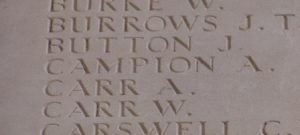
Alban Davy Crompton, Private, 32528, South Lancashire Regiment. Davy was born in Brongest in 1898, the son of David Johnson Crompton and Mary Crompton (nee Davies). The family had lived at Gynt, Pantyrhaidd for many years, before moving to Pantyblodau, Llanynis. Davy worked as a waggoner before enlisting at Preston into the Royal Field Artillery on 10 May 1917. He was then transferred to the Machine Gun Corps, and after training, landed in France on 13 December 1917, where he was attached to the 1/5th Battalion, South Lancashire Regiment. The battalion was attached to 166 Brigade, 55th (West Lancashire) Division, and was rebuilding after being virtually annihilated during the Battle of Cambrai on 30 November. The division was withdrawn from the area and sent to Bomy, near Fruges for intensive training, before relieving the 42nd (East Lancashire) Division in the front line at Givenchy and Festubert on 15 February. It faced several enemy raids in March, but on 9 April was hit by the full force of the German Lys offensive and saw heavy fighting over the following days. Davy was killed in action during the defence of Hazebrouck on 12 April 1918, aged 18. He is buried in Vieille-Chappelle New Military Cemetery, Lacouture, France. Alban is also commemorated at Bryngwyn Chapel, Newcastle Emlyn. He is commemorated in Nazareth Chapel, Llangammarch Wells and not on the Church memorial.
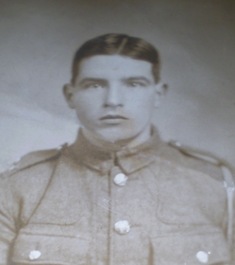
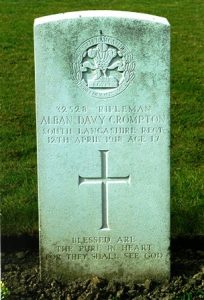
Arthur Ivor Davies, 355426, Royal Welsh Fusiliers. Arthur was the son of Arthur Samuel Davies and Ann Eliza Davies (nee Lewis), of Danyrallt, Llanynis. He enlisted at Welshpool into the Montgomeryshire Yeomanry on 11 June 1915 and was posted to the 3/1st Battalion at Brecon. He was then posted to Norfolk to join the 1/1st Battalion, Montgomeryshire Yeomanry, which was attached to the 1st Mounted Division. On 4 March 1916 the Division sailed for Egypt to join the EEF. On 4 March 1917 the battalion merged with the Welsh Horse Yeomanry to form the 25th (Montgomery & Welsh Horse Yeomanry) Battalion, Royal Welsh Fusiliers, as part of the newly formed 231 Brigade, 74th (Yeomanry) Division. The Division assembled in Egypt as part of the EEF, before crossing the Suez Canal into the Sinai, and saw its first major action during the Second Battle of Gaza. The battle was a failure, and the EEF was re-organised under a new commander, Sir Edmund Allenby, before launching the Third Battle of Gaza on the night of 31 October 1917. This assault was launched along a winder front, running from Gaza to Beersheba, and this time the EEF prevailed, opening the door to Jerusalem. Arthur was wounded soon afterwards and was evacuated to the Citadel Hospital at Cairo. He died of wounds there on 4 December 1917. The 21-year-old is buried in Cairo War Memorial Cemetery, Egypt. Arthur is commemorated in Nazareth Chapel, Llangammarch Wells and not on the Church memorial.
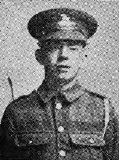
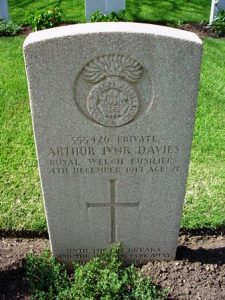
Benjamin Frank Davies, Private, 24361, Royal Welsh Fusiliers. Benjamin was the son of Lewis Davies and Ann Davies, of Ashfield House, Garth. He worked as a Clerk in London prior to the war and lodged at 12, Atherstone Mews, Gloucester Road, London. Benjamin enlisted into the 3rd Battalion, Royal Welsh Fusiliers in London on 29 May 1915 and was posted to the Depot at Wrexham. On 26 October 1915 he was posted to the Mediterranean, to join the 8th Battalion, Royal Welsh Fusiliers, which was on the Gallipoli Peninsula attached to 40 Brigade, 13th (Western) Division. He arrived on the Peninsula as the Gallipoli campaign was drawing to a close and during the onset of a terribly cold winter, with weather so bad that trenches flooded, and bodies were washed out of their graves. The Division was evacuated from Suvla on 19 December 1915, whereupon the infantry moved after a week’s rest to the Helles bridgehead, where it faced the last Turkish attacks at Helles. On 8 January 1916, the Division was evacuated from Helles, and by 31 January was concentrated at Port Said, where it held forward posts in the Suez Canal defences. On 12 February 1916 the Division began to move to Mesopotamia, to strengthen the force being assembled for the relief of the besieged garrison at Kut al Amara. By 27 March, the Division had assembled near Sheikh Saad, coming under orders of the Tigris Corps, and then took part in the attempts to relieve Kut. However, after these efforts failed and Kut fell, the British force in the theatre was built up and reorganised. The Division then fought at the Battle of Kut al Amara, then at the capture of the Hai Salient and the capture of Dahra Bend. It took part in the passage of the Diyala, in the pursuit of the enemy towards Baghdad, and part of the Division became the first British troops to enter Baghdad. Benjamin was killed in action in Mesopotamia on 3 February 1917. The 26-year-old has no known grave and is commemorated on the Basra Memorial, Iraq.
Benjamin Rees Davies, Air Mechanic 2nd Class, 56014, Royal Flying Corps. Benjamin was born in London in 1876, the son of John and Margaret Davies. His parents were both originally from Talgarth. He worked as a dairyman prior to enlisting into the Duke of Cambridge’s Own (Middlesex Regiment) on 4 February 1901 and later that month embarked for South Africa with the battalion, to serve in the Anglo Boer War. After the war Benjamin returned to London where he married Ethel Mary Wilson in 1905 and the couple then moved to Ty Clyd, Llangammarch Wells, where Benjamin worked as a tailor. The couple had two sons, Brenig and Howard. Benjamin enlisted into the Royal Flying Corps on 6 February 1917 and was posted to Ayr in Scotland. Soon after arriving at Ayr Benjamin took ill and died on 14 February 1917. The body of the 41-year-old was returned home, and he was buried in St. Cammarch’s Churchyard, Llangammarch Wells.
David Rees Davies, Sapper, WR/215376, Royal Engineers. David was the son of David and Mary Davies, of Llangammarch Wells. He married Mary Jane Jones at Knighton on 6 October 1900 and the couple set up home at Cwmdylan Farm, Llangammarch Wells, where their three daughters were born. David had worked for many years as a Platelayer for the London and North Western Railway on the Swansea to Craven Arms line but was working for Victoria Cement Works prior to the war. He enlisted at London into the Royal Engineers on 4 June 1915 and with his skilled background, was posted to the 115th Railway Company, Royal Engineers. David embarked for France with the Company on 3 September 1915 and entrained for Marseilles, where the Company embarked for Egypt, landing at Alexandria on 21 December 1915. He served in Egypt for over a year, then following the advance of the EEF into Palestine, served in Palestine, repairing, and constructing railways, until the summer of 1917 when he fell ill. David was then evacuated home aboard the Hospital Ship Llandovery Castle on 23 August 1917 after being diagnosed as suffering from carcinoma of the stomach and was treated at Bury St. Edmunds before being transferred to the 3rd Western General Hospital at Newport. He died there on 30 August 1918. The body of the 39-year-old was brought back home, and he was buried in St. Cammarch’s Churchyard, Llangammarch Wells.
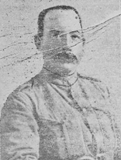
Idris Powell Davies, Second Lieutenant, Cheshire Regiment. Idris was born on 24 June 1896, the son of David Davies and Mary Davies, of Garth Mill Farm, Garth. He worked with his brother at Davies and Vick grocers, The Circle, Tredegar prior to enlisting in the summer of 1916 as a Private into the Welsh Field Ambulance, which was attached to the 68th (2nd Welsh) Division. He spent much of his time at war on home service but was commissioned as Second Lieutenant into the Cheshire Regiment on 26 February 1918. Idris was then drafted to France on 17 June 1918 and was posted to the 7th Battalion, King’s Shropshire Light Infantry, which was attached to 8 Brigade, 3rd Division. Idris joined the battalion in reserve at Gosnay, then on 4 July the 7th KSLI moved into the front line at Locon to begin a short spell in the trenches. The 3rd Division was then relieved by the 19th (Western) Division and moved by bus to Dieval where intensive training was carried out. The 7th KSLI moved to Saulty on 13 August and to Monchy three days later, taking up assembly positions at Adinfer Wood. Here the battalion received orders to carry out an attack on the line of the Arras to Bapaume railway, between a level crossing and a sunken road. The attack was launched at 04.45 on 21 August 1918, as part of an overall advance by the British on the Somme front. By 07.30 the battalion had captured all its objectives. Idris was struck in the head by a machine-gun bullet during the attack that day and died soon afterwards. The body of the 22-year-old was carried back behind the lines and he was buried in Bienvillers Military Cemetery, France.
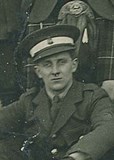
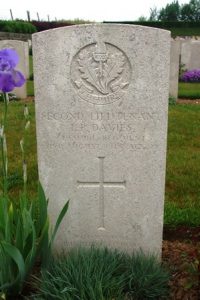
William John Gerrish, 28286, South Wales Borderers. William was born at Rumney in 1882, the son of Thomas Gerrish and Edith Ann Gerrish (nee Phillips). He came to Llangammarch to work as a rural postman, between Garth and Abergwessin and married Tabitha Eliza Morris at Llanllywenfel on 21 August 1905. The couple lived at Aberbutram, Garth, where their two sons, Ethelbert and Athelstan, were raised. William enlisted into the army in November 1915 and was placed on the Army Reserve, before being mobilised in July 1916 and left Garth for Brecon to join the South Wales Borderers. William was then drafted out to Mesopotamia to join the 4th Battalion, South Wales Borderers, which was attached to 40 Brigade, 13th (Western) Division and spent the rest of the war fighting in the campaign in Iraq. By the time that William was demobilised on 24 April 1919 and returned home, he had contracted malaria. The family then moved to 196, Middle Street, Swansea for a short time before moving to 1, Post Office Row, Garth. William died of heart disease at home on 4 February 1920. The 37-year-old was buried in Llanlleonfell Churchyard five days later.
Hugh Stanley Hughes, Private, 78073, Welsh Regiment. Hugh was the son of Richard Hughes and Annie Hughes, of Tynygraig, Llanynis. He worked as a farm labourer prior to enlisting into the Training Reserve in May 1918, before being posted to the Welsh Regiment, probably at Kinmel Park. Hugh never served overseas but remained at Kinmel Park after the Armistice. He was discharged from the army as medically unfit on 26 February 1919 after having been diagnosed as suffering from pthisis and returned home to Llanynis. He died of tuberculosis on 14 July 1921. The 25-year-old was buried in St. David’s Churchyard, Maesmynis two days later. Hugh is not commemorated by the CWGC. He is commemorated in Nazareth Chapel, Llangammarch Wells and not on the Church memorial.
Evan James Jones, Private, 39775, Machine Gun Corps. Evan was the son of Mary Anne Jones, of Ffosyffynnon, Llanwrtyd Wells. He worked for William Williams, of Myrtle House prior to the war. Evan enlisted at Llandovery into the 3rd Battalion, Welsh Regiment, joining the battalion at the Barracks at Cardiff. Evan was then transferred to the Machine Gun Corps at Grantham. He came home on leave in January 1916, then returned to Grantham, where he sadly took ill and died of pneumonia on 12 February 1916. The remains of the 19-year-old were conveyed home and he was buried with full military honours in Cefn Gorwydd (Gosen) Calvinist Methodist Churchyard.
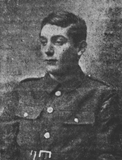
Thomas John Jones, Private, 73285, Royal Welsh Fusiliers. Thomas was the son of Rees Jones and Catherine Jones, of 2, Bridgend, Llangammarch Wells. He enlisted at Brecon into the army and after completing his training, was drafted to France in the summer of 1917, joining the 2nd Battalion, Royal Welsh Fusiliers, which was attached to 19 Brigade, 33rd Division. The battalion had suffered heavy casualties during the Battle of Arras and then moved out of the line for a rest, until moving back into the trenches at Moyenville on 19 June. Two weeks later the Division was relieved, moving to Airaines, where it spent almost a month before taking over front-line positions on the Channel coast, near Bray Dunes, in the Nieuwpoort Sector. The intention was for the Division to launch an assault along the coast but following the failure of the army to break out at Ypres, the Division was rushed to the city, before taking over positions facing Polygon Wood by 25 September, joining the Passchendaele offensive. Over the coming days the Division saw terrible fighting for the wood, before being relieved, and moved to the Messines Sector the following month. On 18 October the 2nd RWF moved back to Ypres, to billets by the Menin Gate, temporarily attached to the Anzac Corps, before returning to the Messines Sector, taking over the left sub-sector of the Divisional front. After several more moves the Division took over the Passchendaele sector on 20 November. Thomas was killed in action here by German artillery fire on 28 November 1917, whilst the 2nd RWF was holding the front line. The 19-year-old is buried in Tyne Cot Cemetery, Belgium. Thomas is also commemorated in Nazareth Chapel, Llangammarch Wells.
Rees Stanton, Private, 24459, Welsh Regiment. Rees was born in 1884, the son of Perry Stanton and Elizabeth Anne Stanton (nee Thomas), of 1, Club Cottage, Llangammarch Wells. Rees had worked as a Groom as a young man, before moving to Mountain Road, Brynamman prior to the war, where he worked as a coalminer at the Blaen-cae-Gurwen Colliery. He enlisted at Cwmgorse into the 19th Battalion, Welsh Regiment, which was the Pioneer Battalion to the 38th (Welsh) Division and joined the battalion in Colwyn Bay. The Division moved to France on 2 December 1915 and moved to the Nursery Sector near Fleurbaix for trench initiation alongside the Guards Division. The Division then held a sector of the line near Cuinchy before marching south to the Somme sector in June 1916 to take part in the assault on Mametz Wood. By now though, Rees had joined a small number of men of the 19th Welsh in becoming attached to the 255th Tunnelling Company, Royal Engineers, which was at work in the Souchez Sector, just to the north and was working on a number of tunnels and drives. The work of the tunnellers was extremely hazardous and during the first week of July work paused for several occasions due to the men hearing the sound of the Germans digging nearby. Rees was killed when the Germans blew a camoflet-a counter-mine-on 17 July 1916. The body of the 32-year-old was recovered and he was buried in Bois-De-Noulette British Cemetery, Aix-Noulette, France. Rees is also commemorated on the Brynamman war memorial.

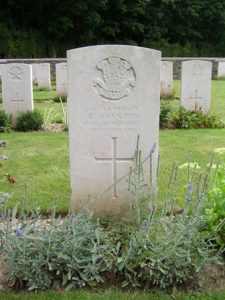
Thomas Edward Stephens, 11208, South Wales Borderers. Thomas was born in 1892, the son of William Stephens and Elizabeth Stephens (nee Bowen), of Leicester House, Llangammarch Wells. Thomas had served with the South Wales Borderers at sometime prior to the war but had left the army and was a Special Reservist. He was working in the Post Office Engineers Department at Swansea when war was declared and was mobilised on 4 August, joining the 3rd Battalion, South Wales Borderers at Pembroke Dock. The battalion moved to the Forth Defences in Edinburgh in November 1914, but due to heavy losses on the Western Front, Thomas was posted to France, embarking on 4 January 1915, before joining the 1st Battalion, South Wales Borderers, which was in Flanders attached to 3 Brigade, 1st Division. Thomas joined the battalion in billets at Bethune, where the men were enjoying a rare respite from the trenches. On 8 January the 1st SWB marched out of Bethune and relieved the 1st Munster’s in the Festubert trenches to begin a routine spell in the line, Thomas’s first taste of trench warfare. Six days later, after a miserable time, the battalion was relieved and marched to billets in Annequin before moving to positions at Givenchy the following day, in snow and rain. The battalion was in the line at Givenchy on 25 January 1915 when the Germans opened an artillery barrage upon its trenches at 08.00. Half and hour later the German infantry attacked and broke through 100 yards of Welch Trench, on the right of the battalion’s line. The 1st SWB sent B Company forwards to counterattack and dove back the Germans. Thomas was killed in action during the fighting that day. The 23-year-old has no known grave and is commemorated on the Le Touret Memorial, Richebourg-L’avoue, France. His brother William died in India in 1916.
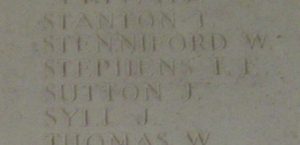
William Bowen Stephens, Sapper, 142158, Royal Engineers. William was born in 1890, the son of William Stephens and Elizabeth Stephens (nee Bowen), of Leicester House, Llangammarch Wells. He worked as a Telegraph Clerk at Llangammarch Post Office prior to the war. William enlisted into the Royal Engineers and with his skill as a telegraphist was posted to Mesopotamia to join the 1/3rd Army Corps Signal Company, Royal Engineers. As well as the obvious hazards of battle, the main issues facing the men in Mesopotamia were the effects of heat and diseases such as malaria. William had not been overseas for long before he suffered heat stroke in the terrible Mesopotamian summer and was evacuated vis ship down the River Tigris to Basra, before being sent to hospital at Bombay to recuperate. William obviously felt better after arriving in Bombay as he wrote several letters to his parents telling them of his experiences. Sadly, he suffered a relapse and he died in hospital on 27 November 1916, aged 26. William was buried in Sewri Cemetery in Bombay, but in January 1962 his grave was exhumed, and he was re-interred in Kirkee War Cemetery, India. William is for some reason commemorated on the Kirkee 1914-1918 Memorial, India.
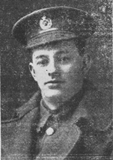
Charles Mills Wilson, Private, RX4/263577, Army Service Corps. Charles was born in Toxteth in 1880, the son of John Wilson and Elizabeth Ann Wilson (nee Maunder). He came to Llangammarch Wells prior to the war after taking up the position of Chauffeur to Miss Price, of the Cammarch Hotel. He enlisted into the Army Service Corps in October 1916 and was posted to Ormskirk, Lancashire for training. Charles had only been with the colours for two months when he took ill and died of pneumonia at Latham Park Camp Hospital, Ormskirk on 17 December 1916. The 26-year-old was buried in Ss. Peter and Paul Churchyard, Ormskirk.
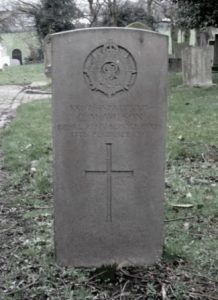
World War Two, 1939-1945
Davy James Jones, Private, 14342324, The Parachute Regiment. Davy was the son of John Jones and Sarah Jones (nee Edwards), of Violet Cottage, Llangammarch Wells. He enlisted into the army, before volunteering for parachute training, and was posted to the 5th (Scottish) Battalion, The Parachute Regiment. The battalion had been formed from the 7th Battalion, The Cameron Highlanders in May 1942 and became part of the 2nd Parachute Brigade, 1st Airborne Division. It was deployed to North Africa in 1943 and on 9 July 1943 the battalion took part in Operation Slapstick, the diversionary landing at the Italian port of Taranto. In November the 1st Airborne Division was withdrawn to England, however the 2nd Parachute Brigade remained in Italy, and was involved in the Battle of Monte Cassino and the fighting along the River Sangro. The 2nd Parachute Brigade then paraded for the Pope in Rome before moving to the Naples area to prepare for the invasion of the south of France, Operation Dragoon. On the morning of 15 August 1944, the battalion landed in the south of France, but due to adverse weather were scattered over a wide area. The various companies then began to move towards the landing zones and came into contact with local Maquis fighters, before carrying out a number of operations against German strongpoints around Fayence. Davy was killed during an attack on a German convoy at the road between Grasse and Draguignan. The 21-year-old was originally buried in Draguignan France American Cemetery, but in February 1947 his grave was exhumed, and Davy was re-interred in Mazargues War Cemetery, Marseilles, France.
Evan John Jones, Sergeant, 744999, Royal Air Force Volunteer Reserve. Evan was the son of John Jones and Ann Jones (nee Davies), of Llandoch, Llangammarch Wells. He emigrated to Canada in 1928 aboard the SS Monthairn. Evan married Margaret Barr Bennett, in York Ontario and the couple had two sons, John and Evan. Evan returned to Britain to enlist into the Royal Air Force Volunteer Reserve soon after the outbreak of war and after completing his training as a Wireless Operator/ Air Gunner, was posted to 264 Squadron, Royal Air Force, which was based at RAF Duxford, equipped with Boulton Paul Defiant fighters. On 29 May 1940 Evan was flying aboard Boulton Paul Defiant I, Serial L6957 on operations over Dunkirk, when it suffered damage following an attack by German fighters. Evan baled out of the aircraft but appears to have come down into the sea and was drowned. His body was recovered, and the 31-year-old was buried in Zuydcoote New Military Cemetery. In July 1948 his grave was exhumed, and he was re-interred in Dunkirk Town Cemetery, France. The pilot of the Defiant, Desmond Hayward Sidley Kay, managed to get his damaged aircraft safely back to England.
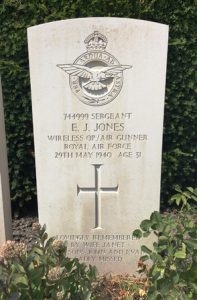
Korea War, 1952-1956
Ryan Conway Cadwgan Powell Jones, Private, 22643122, Duke of Wellington’s Regiment (West Riding). Ryan was born on 5 May 1931, the son of Cadwgan Powell Jones and Sarah Ann Jones (nee Williams), of Craigynos, Llangammarch Wells. He enlisted into the Duke of Wellington’s Regiment (West Riding). Ryan was deployed to Korea with the 1st Battalion, Duke of Wellington’s Regiment in 1952. Korea had been liberated from the Japanese in 1945, but the North of Korea had been ‘liberated’ by Russian Forces, thereby splitting the country in two, and a communist government was formed. On 25 July 1950, The North Korean Peoples’ Army crossed the 38th Parallel and invaded South Korea and the unprepared South Korean and US forces were driven south, forming a defensive perimeter round Pusan. General Douglas MacArthur, the hero of the Pacific War, despatched reinforcements from Japan to help push the Communist forces back across the frontier at the 38th Parallel. He then advanced into North Korea, despite orders from the US President to desist. This prompted the Chinese to send troops into North Korea and Russia warned the US of a potential escalation into all-out war. The Chinese and North Koreans vastly outnumbered the US and South Koreans, who were pushed back over the 38th Parallel, where both forces entrenched. The Duke of Wellington’s landed at Pusan on 30 October 1942 as part of the 1st Commonwealth Division, sent to aid the US, and went into the line at Yong Dong, relieving the 3rd Battalion, Royal Australian Regiment. There were several clashes with North Korean forces over the winter, then at the end of January 1953 the Commonwealth Division was pulled out of the line to train. The Division went back into the line in April and on the night of 12 May 1953 the Duke of Wellington’s took up defensive positions on the Hook, an important defensive feature overlooking the Samichon valley, which led to Seoul. The Communist troops began attacking the Hook soon afterwards and fierce fighting ensued. Ryan was killed in action at the Hook, on 27 May 1953. The 22-year-old was buried on the battlefield, but after the armistice on 27 July 1953, he was re-interred in the UN Memorial Cemetery, in Pusan, in Section 39, Row 9, Grave 3417.